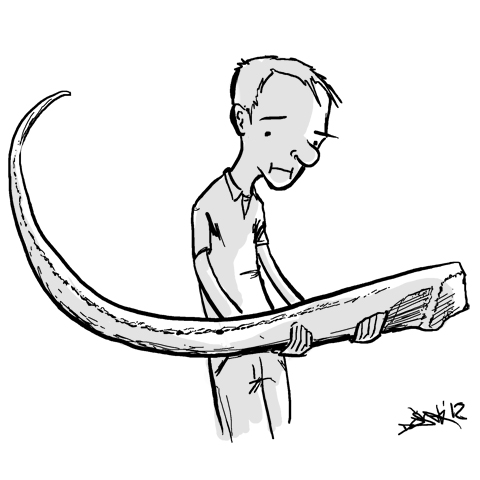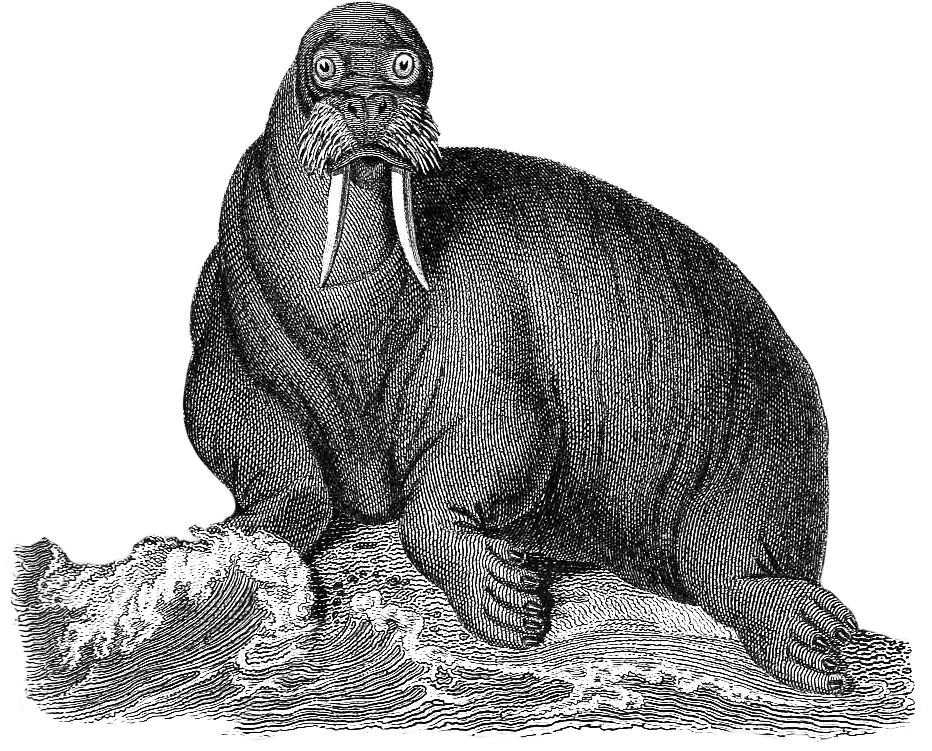This is the third installment of the occasional series Thank God It’s Penis Friday. The first was on banana slug sex; the second on Iceland’s Phallological Museum.
 Today we are going to talk about penis bones. The penis bone, or baculum, is the supportive bone in the penises of most mammals. Relax, you didn’t miss anything: humans are among a minority of mammals that don’t have one. Mice, rats and all the other rodents have tiny bacula in their tiny penises. So do bats, shrews and moles; all the carnivores (bears, lions, weasels, dogs, cats); their aquatic relatives the seals, sea lions, and walruses; and nearly all primates, not excepting our close relatives the chimpanzees and gorillas.
Today we are going to talk about penis bones. The penis bone, or baculum, is the supportive bone in the penises of most mammals. Relax, you didn’t miss anything: humans are among a minority of mammals that don’t have one. Mice, rats and all the other rodents have tiny bacula in their tiny penises. So do bats, shrews and moles; all the carnivores (bears, lions, weasels, dogs, cats); their aquatic relatives the seals, sea lions, and walruses; and nearly all primates, not excepting our close relatives the chimpanzees and gorillas.
The baculum sits in the tip, or glans, of the penis and ranges in size from a few millimeters in gorillas and mice to a quite serviceable 3 inches in larger dogs. And then there’s the somewhat disturbing two-foot long baculum of the walrus. The Internet is rife with mentions of this natural wonder, but nobody says much except that it’s really, really big.
A baculum mainly does two things. First, it stiffens the penis and presumably helps males maneuver the penis inside the female, although, to be honest nobody really knows for sure. (Bonus points: Design a controlled experiment to test this hypothesis.)
Second, by preventing the tip of the penis from buckling during copulation, the baculum prevents the urethra—the tube in the middle through which urine and ejaculate flow—from folding over. Just as bending a straw keeps milkshake from flowing through it, bending the urethra would stop ejaculate in its tracks—a big no no in the world of natural selection. No ejaculate, no future generations with your own adorable traits. So a baculum seems like a really useful technology. You’d think your modern guy would have one.
I first encountered the baculum as an undergraduate in college, when a male graduate student informed me that my senior thesis advisor was one of the world’s foremost authorities on the mouse baculum. “The what?” I asked.
It turns out that my advisor was not alone. There is a vast scientific literature on the bacula of rodents. Because the exact shape of this tiny bone is virtually unique to each species, zoologists have been quietly using baculum shape to classify rodents and other animals since the late 18th century. Burt (1936) felt the topic has been “virtually neglected by American investigators,” but hundreds of papers followed. Johnson (1959) cited baculum size in describing the heather vole. Long and Frank (1968) discussed at length how animals such as weasels might use the baculum during intromission. Who knew that so many men of letters had spent so much time thinking about penis bones?
You’d think we’d know why human males don’t have one, but until recently researchers have said little about the absent human baculum. This painful silence left plenty of room for wild surmise. Gilbert (2001) proposed that in the Bible Adam’s “rib” was really a baculum. According to this interpretation, Man lost his baculum in the Garden of Eden when God took it from a sleeping Adam to make Eve. This is as good an explanation as any, I suppose. You may also have read on the Internet that humans rely on hydraulics instead of a bony baculum, except that, in fact, the other mammals have hydraulically powered penises and a baculum, too. Some will tell you that, walruses aside, the penis bone is a vestigial trait, like the appendix, and humans just happen to have dispensed with it.
In the last decade, a handful of investigators have tackled the problem more scientifically. In a wide variety of mammals, researchers report, the longer the intromission (that’s how long the male is inside the female), the longer the baculum. Dogs protract the process for up to an hour. Bush babies—those cute nocturnal primates with the big black eyes—“intromit” for up to two hours at a time and have gargantuan bacula.
This raises questions. It’s not as if human males don’t engage in some fairly lengthy intromissions, at least at times. Possibly those times have not been a driving force in our evolution. Possibly those times have been comparatively rare in the larger scheme of things. It’s hard to say.
In mammal species in which females mate with multiple males, the males have to compete with one another, often by removing each others sperm or by swamping out the last guy’s sperm with massive volumes of the new guy’s sperm—a process called sperm competition. In such promiscuous species, the males have large testes and long bacula. But in species like gorillas in which females mate with just one male, the males have small testes and bacula.
Which are humans? A lot of people assume that humans go both ways, that we are partly monogamous and partly promiscuous. But the answer is pretty much right there in front of us. First of all, it turns out that human males do have a sort of baculum. It’s so small that it went unnoticed until 2005, when an enterprising Taiwanese urologist discovered a “distal ligament” in the glans of the penis. He thinks this small ligament develops from the same tissues as a true baculum and serves the same function, keeping the urethra wide open when the ejaculate comes flying through.
Virtually all of the physical evidence—including the small size of human testes (sorry, guys), the vanishing baculum, and several other arrangements too complex to explain here—suggests that human males belong squarely in the gorilla camp and have not engaged in serious sperm competition for hundreds of thousands of years.
No sperm competition means either monogamy or polygyny (one male, multiple females, no other guys). And that, in turn, means either a heavy tendency towards monogamy or—since we have a 50:50 sex ratio—vast numbers of men sitting sadly on the edge of the gene pool for thousands of years. To put it another way, if human males had really evolved to mate like, I don’t know, hedge fund managers, they’d have bacula like walruses.
Guest poster Jennie Dusheck is a freelance science writer who lives in Santa Cruz, California, and specializes in biology. She is author or contributor to several college biology textbooks. She likes to take long hikes. More likely, she is sitting at the computer obsessively researching topics like the evolution of human diet, the sports industry, or the status of women.
Her son Daniel Wilkes drew the cartoons and son Charlie Wilkes edited the walrus image, which came from the 1820 Universal Dictionary of Arts, Sciences, and Literature.


I’m really getting sick seeing so many articles about the variety of penises out there in the animal kingdom. I mean really, why do we care so much about penises more than animal vaginas? Surely if the penis of a duck is facinating the vagina that has to deal with it is equally or more so.
I agree. In fact, while I was reading academic material for this post, I was struck by how some researchers talked as if a vagina was simply a uniform tube. Maybe LWON will find room for a discussion of comparative vaginalogy. Maybe occasional Wednesdays?
Interesting article. Thanks. There’s a TED talk where the speaker seems to draw the opposite conclusion about humans. Check it out: http://www.youtube.com/watch?feature=player_embedded&v=54uG_6dtMoU#!
Thanks for the link to psychologist Christopher Ryan’s TED talk. I have to say though that he’s pretty far off the mark.
Ryan’s argument that humans are adapted for sperm competition probably stems from a 1984 paper by Smith that has since been overturned. In his TED talk, Ryan states that the human penis is longer than that of other primates and that the testes are larger than those of polygynous and monogamous primates. Neither is true.
The human penis is of about the same length as that of other primates. According to Alan Dixson (2009), Smith’s 1984 paper was based on sparse and faulty data on the lengths of erect penises in other primates. Researchers have been hard at work since then collecting better data. If you graph penis length against body weight in primates, erect human penises are close to the regression line. That is, they are typical of primates, not unusually long.
Human testis size is on the small size when compared to body weight and groups well with polygynous primates. Human sperm production is low compared to those of promiscuos primates (and just one-sixth the rate for rats). The proportion of defective sperm in humans (about 27%) is comparable to that of gorillas, which are polygynous breeders. In contrast, promiscuous chimps and bonobos have only about 2 – 3% abnormal sperm. Along with the small or absent baculum, the physical evidence strongly implies that humans are not adapted for sperm competition.
“Researchers have been “hard” at work since then collecting better data.”
Good one.